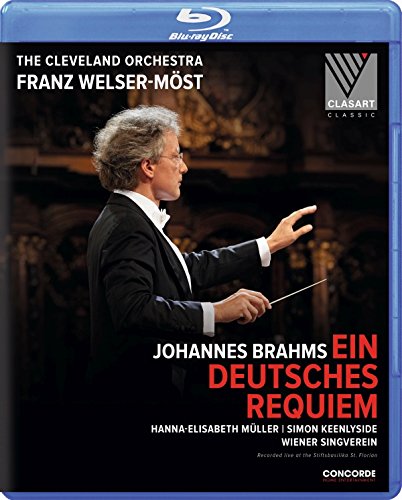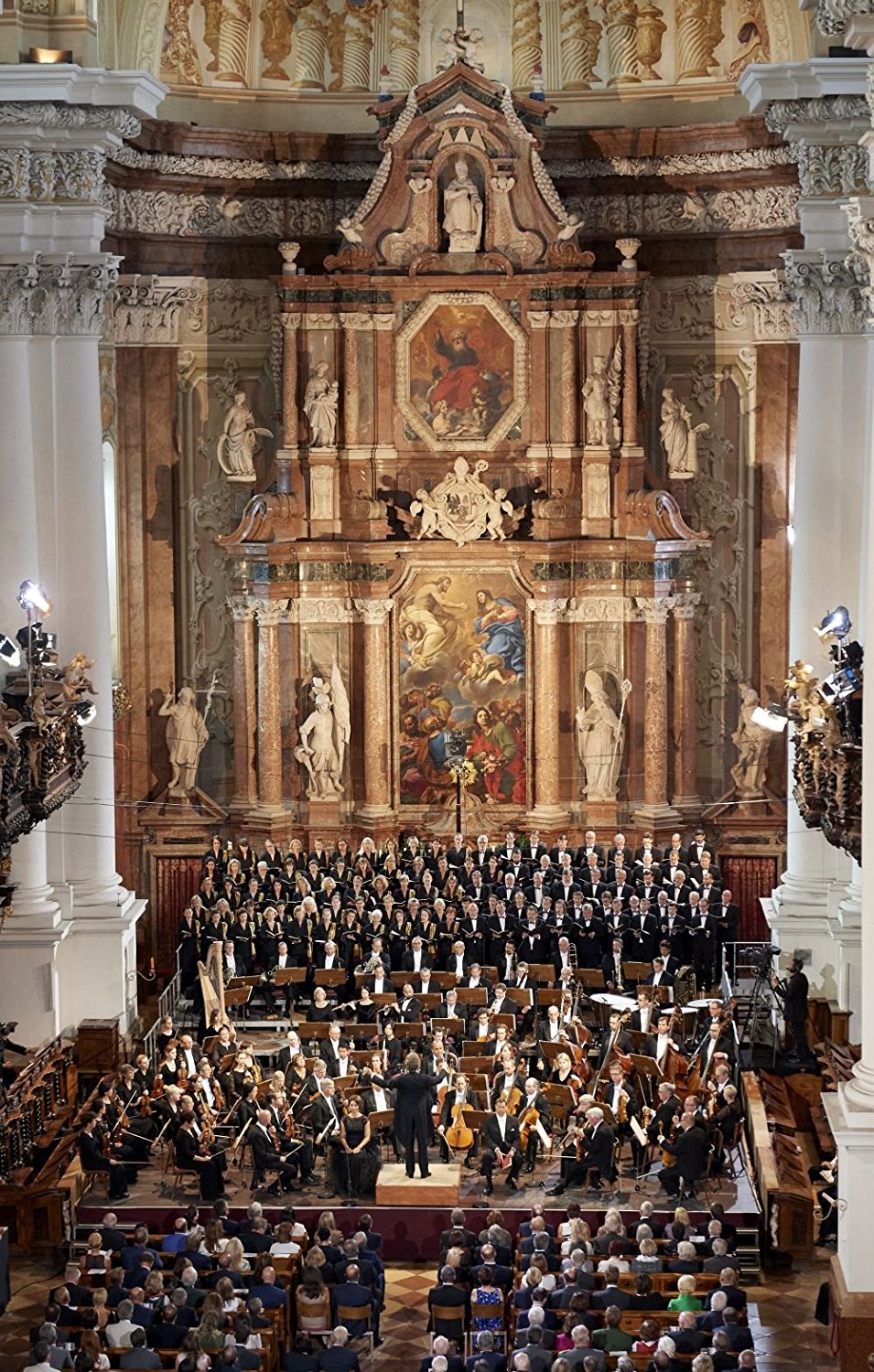

Brahms Ein Deutsches Requiem concert. In 2016 Franz Welser-Möst conducted the Cleveland Orchestra and the Vienna Singverein. Welser-Möst was back at his home-town church in Austria, the Stiftsbasilika Monastery in St. Florian. (The thumbnail picture above was made with a still camera for disc PR; for much more on this beautiful church see our review of a Bruckner Symphony No. 4 concert by the Cleveland Orchestra and Welser-Möst at the same Stiftsbasilika.) Soloists are Hanna-Elisabeth Müller (soprano) and Simon Keenlyside (baritone). Directed for TV by Brian Large. (This title complements the three Blu-ray box set Johannes Brahms Cycle.) The video was made in 1080p rather than 1080i. Sung in German. Released 2016, disc has 5.1 dts-Master Audio sound. Grade: A
This title is a winner! It may be the best symphony recording ever made by a Western recording company. (The only better recordings would be those state-of-the-art demo discs made by NHK in Japan.) Before I fill your plate with too much text, I'll serve some screenshots appetizers.
First below is Brian Large's shot of the whole orchestra and chorus with the alter. It's maybe even prettier than the PR photo. In an ordinary hall, we would call this an "anthill" shot of little value as the orchestra fills only a small part of the view. But given the visual interest inherent in this venue, I counted every zoomed-out shot of the orchestra and choir as Other high-value in my video statistics discussed later.
And next is a view from the midst of the chorus looking toward the entrance of the church. On the second floor you see a magnificent organ. That's the Anton Bruckner Organ. That's where Bruckner played for church services for many years while dreaming about marriage to beautiful young girls (who always turned him down) and also about the symphonies that he, as penitent, would write for God (who always accepted them). Bruckner is buried below the church in a spooky crypt. (You don't get these kinds of signals from a CD.) Well, in an ordinary hall, we might mark down this shots as being nothing more than conductor-over-backs (C/B) view. But in this extraordinary venue, this is a high-value shot also:
With total control over his craft, Brian Large gives us this magnificent view of the total forces engaged. We call this kind of view a whole-orchestra (WO) shot:
And here next below is a fabulous, rare shot showing all the violins and all the cellos in action. This we call a large-group (LG), or part-orchestra (PO) shot:
Now I hope these tasty treats have whetted your desire to move on the next course of some what tough beef: our analysis of what makes for proper video content in an HD recording of a symphony (see, if you dare, our special article on this subject).
I used a Wonk Worksheet to record the information in the next two paragraphs. All this will be used to evaluate the video content of Large's recording.
Length = 67 min 20 s (00:01:09 to 01:08:29) for 4040 seconds of music
Total video clips = 286
Breakdown of clip types:
Conductor shots (C) – 30 clips
Conductor-over-backs (C/B) – 30 clips
Soloist(s) not realistic – 7 clips
* Soloist(s) realistic – 25 clips
Solos, small sections (S§), small groups (SG), & misc. small-scale or DVD-like views – 100 clip
* Large section (L§), large groups (LG), & misc. large-scale or HDVD-like views – 17 clips
* Part orchestra (PO) – 22 clips
* Whole orchestra (WO) – 19 clips
Instrument only (IO) – 1
Other low value – 1
* Other high value – 34
* = Supershots (you will see later how important these "Supers" are to us)
Now I'll give you more screenshot examples of what we mean by the different clip types I just listed.
Consider the next shot below. Should it be called a low-value "anthill" or a high-value shot? I call it high-value. You clearly see how the center aisle is filled with extra chairs for the overflow crowd adding to the ocean of people attending. And will you forgive me for loving those lamps adding visual interest? Well, another viewer might easily condemn this shot full of bald and gray heads as low-value. It's not easy being an art critic:
We saw this next shot before and called it high-value because the church is so pretty. But in an ordinary hall, we would call this a low-value conductor-over-backs shot. We don't like C/B shots because you can't see the conductor well, and it's insulting to the wonderful musicians in the Cleveland Orchestra to make a video of their backs! It also seems to be the kind of shot we see too much in old-fashion and now obsolete DVDs of symphonies:Johannes Brahms CycleJohannes Brahms Cycle
Next below is a typical bad C/B shot. The PQ is fine, but it's a lazy view that doesn't tell up much:
I counted 100 choristers in the Wiener Singverein. The Wonk Worksheet Instructions contains the following guidance for assigning clip categorizations to choir shots:
For a larger choir of 60 or more, a shot of 8 to 12 choristers might feel like a close-up of a bunch of heads. But when the shot includes more than 12 singers, we might feel that we are getting an audience-like perspective.
I felt that most choir shots in this title are like “a bunch of heads” and therefore deserve classification as Misc. small-scale. For examples, I counted the next 5 shots as small-scale. Another viewer might easily consider some of these shots to be Misc. large-scale images. I was definitely influenced by the camera angles that obscured back-row choristers:
The next 4 shots are definitely Misc. large-scale or Large Section (L§). The first of these 4 shots is, I think, the entire bass section:
Most part-orchestra (PO) clips were taken from this vantage:
The next 3 pictures are some of the less-frequently used PO views:
We are generally wary of too many aerial-perspective shots. But I called this next view an interesting WO shot:
Next below is a more traditional WO view:
Finally, to our excellent soloists! We previously noted that 78% of soloist shots were realistic. The Wonk Worksheet Instructions would normally require us to see the waist (or more) of a vocal soloist to call the shot realistic. I felt the next shot below of Mr. Keenlyside) is just passes the test:
I believe the shot below of Ms. Müller was taken from the same camera as the shot above, but it is slightly more zoomed-in. This is too close to be realistic. We have no problem with moderate use of close-ups in symphony recordings. But we want to avoid making a symphony video that's mostly or entirely made of close-ups. That's the way symphony videos were made in the bad, old DVD days:
The next shot of Keenlyside below has an audience-like perspective. It is clearly realistic:
I only found a single Other low-value shot in this video. This was an 8-second shot mostly of Welser-Möst’s curly gray locks. The full impact perhaps doesn’t come across in this still image, so you’ll have to trust me:
It's far better, in my opinion, to film the conductor from the front view:
Now to our grade. If you would read our special article on the subject, you would see how we arrived at the following definition for a good symphony HDVD:
A good HDVD should have a slow pace with more than 10 seconds per video clip on average (longer the better). 20 to 40% of the clips should be large-scale supershots (higher is better). Conductor shots should be less than 20% of the clips in the video (way less really). Over 50% of soloist shots should be realistic.
So how does subject title stack up? The next step is to use a filled-in Work Worksheet to make some calculations:
By dividing the total number of 4040 seconds by 286 video clips, we see that the pace is 14.1 seconds per clip. Subject title passes the pace test comfortably.
Supershots (Soloists realistic, L§, LG, PO, WO, Other high-value) = 41% Check out our math. Subject title has lots of large-scale, high-value shots.
Conductor (C + C/B) = 21%. Well, there are too many conductor shots, and the disc flunks this test, but not by much.
% Soloist(s) realistic = 78% Great job---another pass.
Following our HDVDarts standards, I started with an A+ grade. The sound on subject title is not published to modern 96kHz/24-bit standards. Still, the SQ is excellent. Instrumental detail is clear throughout, and the choral sound is ravishing. Therefore, only a partial grade deduction is given for sound, bringing us to an A. PQ throughout is excellent (1080p rather than 1080i) with remarkably few errors, so no further deduction is necessary for PQ.
Now we consider video content. The video passes the pace, supershots, and soloist tests discussed above. A grade deduction is required for too many conductor shots. This results in a B.
But that's too low for this fantastic title. The disc passes 3 of the 4 video content tests easily and just barely flunked the conductor test. So I give the grade a bump up B+. Second, it's time now to comment on the musical performance. Any time the Cleveland Orchestra plays with Welser-Möst in his home-town church, you can count on a superb performance. Add in the Weiner Singverein and top off with excellent audio and video and the result is a thrilling and life-affirming event. So for all this I'll bring the grade back up to a solid A. We have been disappointed so many times in recent years with poor video content in our symphony HDVDs. But this title likely will hold up for you through repeated viewings even as we move into the age of 4K.
PS1: If you are regular reader, you will note I got through this review without using the word DVDitis. If you are new to us, you can learn about DVDitis here. Subject title is available in both DVD and the HDVD (Blu-ray). But I think Brian Large was probably instructed to optimize this video for HDVD presentation rather than for the DVD buyers. If I'm right about this, this title is probably a milestone in our industry and supports our prediction that DVD will soon be another legacy format.
PS2: Think we are crazy for stepping through the clips in fine-art videos and considering the quality of each one? Well, it's surprising how much you can learn about the performance and the recording by doing this. The Work Worksheet lets you actually understand what you are watching and why it's good or bad. It takes some work. Consider the Keeping Score Mahler Symphony 1 performance by the San Francisco Symphony. In a piece shorter than this Ein Deutsches Requiem, there were 890 video clips---that's a vertigo-inducing video pace of 3.6 seconds per video clip. No wonder that San Francisco video is tiring to watch.
After doing the work to fill out a Wonk Worksheet, it makes sense to share it. And we think this is the first time any fine-arts criticism has been done in a way that can be objectively peer reviewed. So grab a Wonk Worksheet off this website and try it on a symphony video we haven't yet wonked. Give us a report we can publish. Peer peer!
OR



























